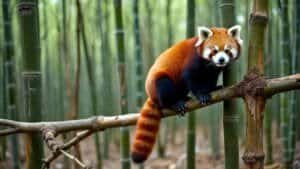Red pandas are charming and elusive forest dwellers facing a multitude of threats in their natural habitats. But what are the primary threats to red pandas in the wild? From the dense bamboo forests of the Eastern Himalayas to the slopes of southwestern China, these endangered mammals are increasingly at risk due to human activities and ecological disruption
This article breaks down the six major threats red pandas face—habitat loss, poaching, disease from domestic animals, bamboo depletion, climate change, and low public awareness. We’ll also explore the effectiveness of conservation responses, from community education and habitat restoration to legal enforcement and disease prevention strategies
Primary Threats to Red Pandas in the Wild

The red panda (Ailurus fulgens), an arboreal mammal native to the Himalayan and Hengduan mountain ranges, is currently listed as Endangered by the International Union for Conservation of Nature (IUCN). Despite its protected status in several countries, wild populations are declining at an alarming rate
Estimates suggest fewer than 10,000 individuals remain in the wild, primarily due to six interrelated threats. These challenges range from direct human interference to broader ecological shifts, each compounding the others in ways that make red panda survival increasingly difficult
Habitat Loss and Fragmentation
The most pressing threat to red pandas is habitat loss. Rapid deforestation for agriculture, logging, infrastructure development, and urban expansion has significantly reduced the amount of suitable forest cover. According to the Red Panda Network, over 70% of red panda habitat in Nepal lies outside protected areas and is now fragmented into more than 400 forest patches. This fragmentation restricts red pandas’ movement, isolates populations, and reduces the availability of food and nesting sites
Habitat loss is particularly problematic because red pandas have highly specific habitat needs. They require temperate forests with dense bamboo understory and old-growth trees that provide nesting hollows. When these forests are cleared or degraded, red pandas often fail to relocate successfully due to their territorial nature and limited dispersal abilities
As seen in India’s Arunachal Pradesh and parts of eastern Nepal, forest patches near human development often suffer from edge effects—drier soil, increased human traffic, and reduced canopy cover—all of which further degrade habitat quality. The National Zoo notes that habitat loss from deforestation is expected to continue due to expanding population pressures in red panda range countries
Poaching and Illegal Wildlife Trade
Although red pandas are legally protected across their range, illegal hunting remains a serious issue. They are poached for their distinctive reddish-brown fur, which is sometimes used to make hats or decorative garments, and are increasingly captured alive for the illegal pet trade. Between 2008 and 2018, Nepalese authorities confiscated 121 red panda skins—a small but alarming number given the species’ limited population
The International Fund for Animal Welfare (IFAW) notes that poaching is often facilitated by weak law enforcement in remote regions, coupled with limited community knowledge about red panda protection laws. Poachers take advantage of the animal’s quiet, non-aggressive nature, and its tendency to freeze or flee into trees when approached, making it relatively easy to capture
Trade routes often span across borders, and live red pandas have been intercepted in transit in India, China, and Myanmar. Because red pandas are solitary and stress-prone, even short periods in captivity often result in death before sale
Impact of Domestic Animals and Disease
As red panda habitats intersect more frequently with human settlements and livestock grazing areas, the threat posed by domestic animals—particularly dogs—has become increasingly apparent. Free-roaming dogs attack red pandas, especially juveniles, and are now considered one of the most direct causes of red panda mortality in community-managed forests
More insidious, however, is the transmission of disease from domestic animals. Canine distemper virus (CDV), which causes high fever, respiratory distress, and neurological symptoms, is often fatal to red pandas. Since wild red pandas rarely come into contact with veterinary care, the spread of CDV poses a serious conservation challenge
Monitoring efforts by the Red Panda Network have shown that areas with higher densities of domestic dogs correlate with lower red panda sightings. Efforts to vaccinate dogs in key buffer zones have been launched, but funding, manpower, and sustained community involvement are ongoing hurdles
Bamboo Resource Depletion
Bamboo forms up to 98% of the red panda’s diet, making it a non-negotiable element of their survival. However, bamboo is increasingly scarce in some parts of the red panda’s range due to deforestation, livestock grazing, and natural die-off cycles. Overgrazing by yaks, goats, and cattle severely damages bamboo growth, particularly at the edges of forest patches
Red pandas require a consistent year-round supply of bamboo, especially during breeding and cub-rearing seasons when energy demands are highest. When bamboo is lost or degraded, red pandas must travel farther to find food—expending more energy and increasing exposure to predators and human threats
Additionally, bamboo is known for cyclical mass flowering and die-offs, which can devastate entire regions for several years at a time. In fragmented landscapes, red pandas have few options for relocation when these die-offs occur, leading to starvation or local extinction events
Effects of Climate Change on Habitat
Climate change exacerbates nearly all the other threats faced by red pandas. Rising temperatures, shifting precipitation patterns, and changing tree line elevations are altering red panda habitats. Forests at higher altitudes are becoming drier and less suitable for bamboo growth, while lower-elevation forests are increasingly encroached upon by human activity
A 2022 study by the Red Panda Network suggests that 35% of red panda habitat could become unsuitable due to climate change by 2070, based on current emission trajectories. These changes force red pandas to move into marginal areas where food is scarce and threats are high
Climate-driven events such as landslides, floods, and forest fires—already more frequent in Nepal and India—further disrupt red panda habitats and limit their ability to find refuge or maintain territory
Public Awareness and Law Enforcement Challenges
Many of the red panda’s threats are exacerbated by low public awareness and inconsistent law enforcement. In rural communities across Nepal, Bhutan, and northern India, knowledge about red pandas is still limited. They are often mistaken for other animals, or their ecological role is not understood, reducing community motivation to protect them
Even where protective laws exist, enforcement is weak. Remote areas often lack park rangers or have under-resourced forestry departments, and penalties for poaching or illegal logging may not be enforced. According to IFAW, only a small percentage of wildlife crimes involving red pandas lead to successful prosecution
Education programs, especially those tailored to schools and local governments, are helping bridge this gap. However, large-scale change will require coordinated efforts across national borders and between governments, NGOs, and indigenous communities
For a comprehensive overview of all six major threats, the Red Panda Network’s threat analysis offers an in-depth look at the multi-layered risks facing this endangered species
Conservation Efforts Addressing Red Panda Threats

The threats facing red pandas in the wild are interconnected and complex, but so too are the solutions. Conservationists, governments, and local communities are working together to implement targeted strategies that not only protect red pandas directly but also restore and preserve the ecosystems they depend on
These strategies span from grassroots efforts to global policy advocacy, addressing everything from habitat restoration and anti-poaching measures to public education and disease prevention
Community-Based Conservation Initiatives
One of the most successful models for red panda conservation is community-based management. Programs like the Forest Guardian initiative, run by the Red Panda Network, train local people to serve as environmental stewards. These guardians monitor red panda populations, report threats, and conduct educational outreach in their communities
In Nepal’s eastern PIT corridor, community forests now play a central role in habitat protection. Local cooperatives manage forest use, enforce anti-logging regulations, and oversee bamboo harvesting schedules to ensure sustainability. These community forests cover significant portions of red panda habitat and act as a buffer between protected zones and development areas
Financial incentives are often integrated into these programs. By linking conservation work with ecotourism or forest product sales (such as medicinal plants or handicrafts), communities are more likely to protect rather than exploit red panda habitats
Anti-Poaching Measures and Law Enforcement
Combatting poaching requires a combination of enforcement and education. Governments in India, Nepal, and Bhutan have increased patrols in known red panda territories and established stricter penalties for trafficking offenses. However, enforcement is often hindered by a lack of resources, particularly in remote areas
Organizations like IFAW support ranger training and provide surveillance equipment, including camera traps and GPS devices, to track illegal activity. Cross-border cooperation between India, China, and Nepal is also improving, particularly regarding wildlife trafficking networks
Awareness campaigns targeting poachers and consumers—especially those in urban and border areas—are crucial to reducing demand for red panda fur and live animals. Education on the legal and ethical implications of the illegal pet trade has been integrated into school curricula in several high-risk regions
Habitat Restoration and Protection Strategies
Habitat restoration is a critical component of red panda conservation. The Red Panda Network’s “Plant A Red Panda Home” project focuses on reforesting degraded patches with native tree and bamboo species. Since 2015, thousands of trees have been planted across the PIT corridor to reconnect fragmented forests and improve habitat quality
In addition to reforestation, landscape-scale planning is underway to ensure ecological corridors are preserved or reestablished. These corridors allow red pandas to move between habitat patches for feeding, breeding, and dispersal—key behaviors necessary for long-term genetic viability
National governments are also expanding protected areas and updating zoning laws. For instance, India’s Wildlife Protection Act and Bhutan’s Forest and Nature Conservation Act have provisions that protect red panda habitats and restrict land-use change in key ecological zones
Education and Awareness Campaigns
Effective conservation depends on public understanding and support. Red panda outreach campaigns are increasingly focused on schools, community centers, and media platforms. In rural areas, theater performances and mobile exhibits educate children and adults alike about red panda behavior, habitat needs, and the legal consequences of harming them
In urban regions and international contexts, red panda awareness is often promoted through zoo partnerships, documentaries, and Red Panda Day events held annually in over 20 countries. These campaigns help build international support and funding for field-based conservation efforts
Organizations like the Smithsonian National Zoo and the Red Panda Network also provide educational toolkits and sponsor training sessions for teachers, forest officials, and local leaders. These tools help foster a culture of stewardship, where red pandas are not only protected but celebrated as a symbol of biodiversity and forest health
For more information about these conservation initiatives and how they are helping to combat the multiple threats facing red pandas, the IFAW’s red panda page offers a current and globally informed perspective












